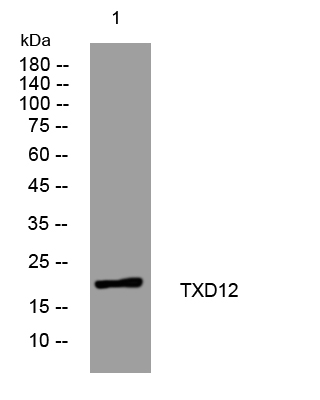TXD12 rabbit pAb
- Catalog No.:YT7124
- Applications:WB
- Reactivity:Human;Mouse;Rat
- Target:
- TXD12
- Fields:
- >>Glutathione metabolism;>>Metabolic pathways
- Gene Name:
- TXNDC12 TLP19 UNQ713/PRO1376
- Protein Name:
- TXD12
- Human Gene Id:
- 51060
- Human Swiss Prot No:
- O95881
- Mouse Gene Id:
- 66073
- Mouse Swiss Prot No:
- Q9CQU0
- Rat Gene Id:
- 298370
- Rat Swiss Prot No:
- Q498E0
- Immunogen:
- Synthesized peptide derived from human TXD12 AA range: 118-168
- Specificity:
- This antibody detects endogenous levels of TXD12 at Human/Mouse/Rat
- Formulation:
- Liquid in PBS containing 50% glycerol, 0.5% BSA and 0.02% sodium azide.
- Source:
- Polyclonal, Rabbit,IgG
- Dilution:
- WB 1:500-2000
- Purification:
- The antibody was affinity-purified from rabbit antiserum by affinity-chromatography using epitope-specific immunogen.
- Concentration:
- 1 mg/ml
- Storage Stability:
- -15°C to -25°C/1 year(Do not lower than -25°C)
- Molecular Weight(Da):
- 19kD
- Background:
- This gene encodes a member of the thioredoxin superfamily. Members of this family are characterized by a conserved active motif called the thioredoxin fold that catalyzes disulfide bond formation and isomerization. This protein localizes to the endoplasmic reticulum and has a single atypical active motif. The encoded protein is mainly involved in catalyzing native disulfide bond formation and displays activity similar to protein-disulfide isomerases. This protein may play a role in defense against endoplasmic reticulum stress. Alternate splicing results in both coding and non-coding variants. [provided by RefSeq, Mar 2012],
- Function:
- catalytic activity:2 glutathione + protein-disulfide = glutathione disulfide + protein-dithiol.,cofactor:FAD.,function:Possesses significant protein thiol-disulfide oxidase activity.,function:Probable oxidoreductase that acts as a caspase-independent mitochondrial effector of apoptotic cell death. Extramitochondrial AIF induces nuclear chromatin condensation and large scale DNA fragmentation (in vitro). Binds to DNA in a sequence-independent manner.,similarity:Belongs to the FAD-dependent oxidoreductase family.,similarity:Contains 1 thioredoxin domain.,subcellular location:Translocated to the nucleus upon induction of apoptosis.,subunit:Interacts with XIAP.,tissue specificity:Widely expressed.,
- Subcellular Location:
- Endoplasmic reticulum lumen .
- Expression:
- Widely expressed.
- June 19-2018
- WESTERN IMMUNOBLOTTING PROTOCOL
- June 19-2018
- IMMUNOHISTOCHEMISTRY-PARAFFIN PROTOCOL
- June 19-2018
- IMMUNOFLUORESCENCE PROTOCOL
- September 08-2020
- FLOW-CYTOMEYRT-PROTOCOL
- May 20-2022
- Cell-Based ELISA│解您多样本WB检测之困扰
- July 13-2018
- CELL-BASED-ELISA-PROTOCOL-FOR-ACETYL-PROTEIN
- July 13-2018
- CELL-BASED-ELISA-PROTOCOL-FOR-PHOSPHO-PROTEIN
- July 13-2018
- Antibody-FAQs
- Products Images

- Western blot analysis of lysates from A431 cells, primary antibody was diluted at 1:1000, 4°over night



